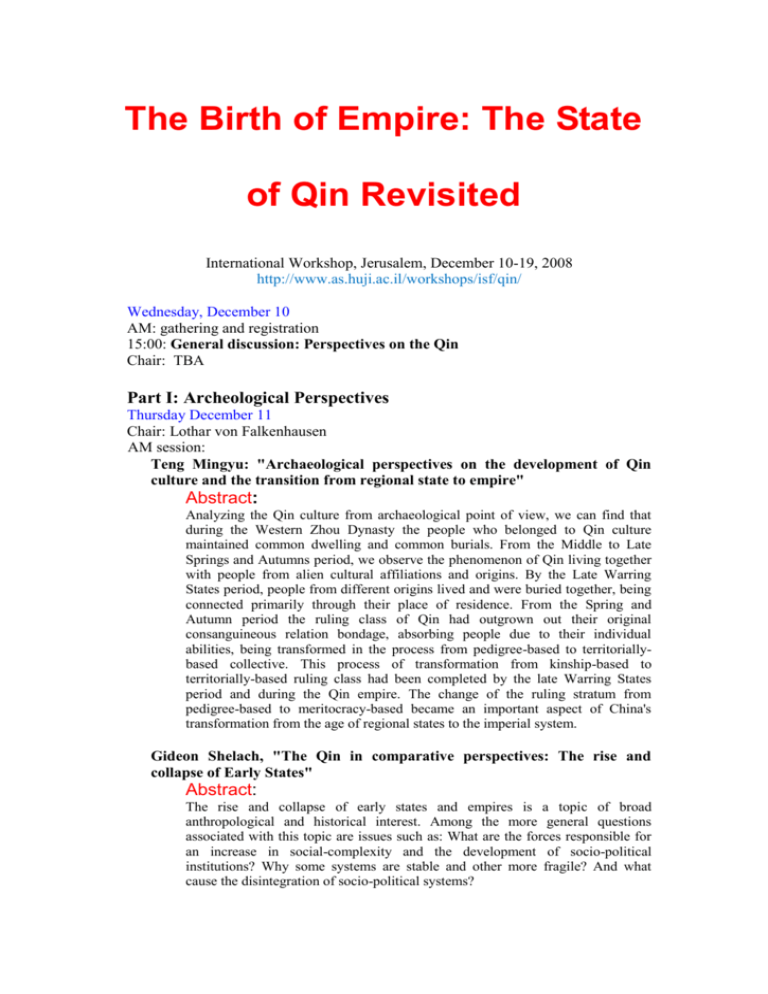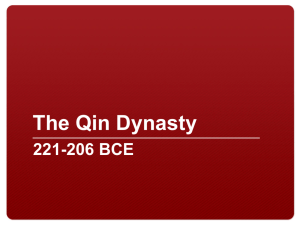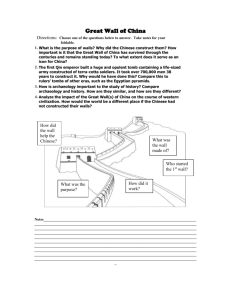The Birth of Empire
advertisement

The Birth of Empire: The State of Qin Revisited International Workshop, Jerusalem, December 10-19, 2008 http://www.as.huji.ac.il/workshops/isf/qin/ Wednesday, December 10 AM: gathering and registration 15:00: General discussion: Perspectives on the Qin Chair: TBA Part I: Archeological Perspectives Thursday December 11 Chair: Lothar von Falkenhausen AM session: Teng Mingyu: "Archaeological perspectives on the development of Qin culture and the transition from regional state to empire" Abstract: Analyzing the Qin culture from archaeological point of view, we can find that during the Western Zhou Dynasty the people who belonged to Qin culture maintained common dwelling and common burials. From the Middle to Late Springs and Autumns period, we observe the phenomenon of Qin living together with people from alien cultural affiliations and origins. By the Late Warring States period, people from different origins lived and were buried together, being connected primarily through their place of residence. From the Spring and Autumn period the ruling class of Qin had outgrown out their original consanguineous relation bondage, absorbing people due to their individual abilities, being transformed in the process from pedigree-based to territoriallybased collective. This process of transformation from kinship-based to territorially-based ruling class had been completed by the late Warring States period and during the Qin empire. The change of the ruling stratum from pedigree-based to meritocracy-based became an important aspect of China's transformation from the age of regional states to the imperial system. Gideon Shelach, "The Qin in comparative perspectives: The rise and collapse of Early States" Abstract: The rise and collapse of early states and empires is a topic of broad anthropological and historical interest. Among the more general questions associated with this topic are issues such as: What are the forces responsible for an increase in social-complexity and the development of socio-political institutions? Why some systems are stable and other more fragile? And what cause the disintegration of socio-political systems? The steady, though not always even, development of the Qin state and empire and its rapid collapse, is interesting not only for its central place in the history of China but also form an anthropological perspective. By placing this trajectory in a comparative framework with other similar trajectories of early states, this paper hope to gain more refine insights about the processes operated in the Qin case as well as contributing the anthropological theory on the state formation and collapse. PM session: Zhao Huacheng and Wang Hui: "Cultural interactions on Qin Western Borders: The Warring States Cemetery at Zhangjiachuan, Gansu"甘肃张 家川战国墓葬的新发现——兼谈战国中晚期甘肃东南部的文化交流 Abstract: 一、张家川战国墓葬的形制和随葬品。均为竖穴土坑带有台阶的偏洞室 墓。大型墓葬有九级台阶,墓道内随葬有车四乘,墓室内随葬车一辆。车 辆装饰以金、银、铜质的车饰,极其华丽。随葬品有鎏金铜壶、鎏金铜 鼎、铜甗、玻璃杯、银杯以及锡制动物和人形俑。出土有含锡量很大的车 马器。车饰主要有镂空三角形和方形铜片饰、大角羊、金银虎形饰片和错 金铁牌饰等。 二、时代和族属。战国中晚期。秦人或戎人。 三、反映的战国时期的秦戎关系。 四、甘肃东南部战国中晚期和北方草原地带的文化交流。 五、该地区战国中晚期和西方的文化交流。 Roundtable: Qin in the Zhou oikoumene and Qin relations with non-Zhou ("non-Sinitic") cultures further to the West and the North Friday December 12 Chair Gideon Shelach AM session: Lothar von Falkenhausen "Preliminary reflections on the Qin economy" Abstract: If it is possible to summarize the numerous archaeological discoveries related to Qin made during the past half-century, one might say that they have greatly relativized previous notion about the radicalness of the changes brought about by the Qin unification. Qin developed quite similarly to the other major kingdoms of the Warring States period, and in conquering all of them, it imposed its own “system” over much of continental East Asia. The Qin system was not different in many decisive respects from those of its rivals; part of the reason for this is that throughout the first millennium BC, China had been culturally and politically more unified than traditional scholarship had recognized; another reason is the pervasiveness of inter-polity communication during the Warring States period, which led to the rapid adoption of innovations independently of existing political boundary. Archaeology does reveal that in certain respects, such as the size of its capitals and imperial tombs, Eastern Zhou-period Qin exhibits a gigantomania that has few parallels elsewhere in continental East Asia. This hints at differences with respect to the concentration of the control of natural and labor resources, especially during the Warring States period. The present paper will move toward a reanalysis of presently known archaeological finds from an economic perspective, in an attempt to probe into the specific economic factors in the Qin unification. PM: Visit to the Old City of Jerusalem Saturday, December 13: Tour to Mazzada and the Dead Sea Part II: State and Society in Qin Sunday, December 14 Chair: Robin D.S. Yates AM session: Hsing I-tien: Administration of household registration and labor obligations of the Qin-Han period according to Liye records Abstract 近年在湖南龍山里耶秦代遷陵縣城遺址井中、湖北江陵鳳凰山十號西漢 墓、安徽天長十九號西漢墓和江蘇連雲港尹灣西漢墓分別出土了和基層戶 口和賦役行政相關的簡牘文書。這些文書已經可以大略呈現出從里、鄉、 縣到郡各級地方政府戶口和賦役行政作業的情況。 本文將以上述出土資料為據,參以傳世文獻,重建秦漢里、鄉、縣、郡掌 控人口和賦役的大致面貌。 Charles Sanft: Mass Communication and Common Knowledge During the Qin Dynasty Abstract This paper argues that the new Qin dynasty adapted and used existing practices and technologies for the purposes of mass communication. The goal of the communication was to create common knowledge of the dynasty among the population at all levels, particularly among the common people. This worked to resolve the coordination problem presented by the unified realm. My interpretation draws from recent transdisciplinary research on the role of communication, cooperation, and persuasion in the organization of human societies. I will use the imperial order of 221 BCE commanding establishment of a unified system of measures, the text of which has been recovered in various forms from numerous sites, as an example of the role of mass communication in Qin rule under the First Emperor and, to a lesser degree, his successor. PM session: Robin D.S. Yates: Slavery under Qin (details TBA) Roundtable: Qin society: the question of social mobility, the existence of independent social elite (or the lack thereof) and the reach of the state Monday, December 15 Chair: Hsing I-tien AM session: Chen Songchang: "General introduction to the content of the Qin slips recently acquired by the Yuelu Academy" Abstract 2007 年 12 月,湖南大学岳麓书院斥重金从香港古玩市场抢救性的收购了一 批濒临损毁的秦简。经文保专家的及时保护和处理,共清理出 2098 个简 号,其中比较完整的有 800 余枚。由于这批秦简在流转的过程中已经散 乱,且多有散失,所以简序已无法按出土状况复原,根据初步的整理,其 内容大致包括历谱、日志、算数书、梦书、官箴、律令杂抄、奏谳书等, 这批秦简中的历谱有秦王政三十四年和三十五年两种,日志则主要是秦王 政二十七年所记。 算数书是迄今所知出土文献中时代最早的算术文献,它比湖北张家山 247 号墓中出土的算术书还要早几十年。梦书也是现在所知最早的出土文献之 一,它与湖北云梦睡虎地秦简《日书》中的占梦不同,是一种不受具体日 期限制的有关梦占的条文汇集。 这批秦简中的官箴内容与云梦睡虎地秦简中的《为吏之道》有些类似,都 是有关为吏为官的箴言,但两者所摘抄的具体内容并不相同,两者可以互 补。 律令杂抄和奏谳书是这批秦简的主要内容,许多条文可以补充云梦睡虎地 秦简中的律文内容,特别是关于令的部分,如 “内史仓曹令”、“内史户 曹令”、“内史官共令”、“四司空共令”、“四谒者令”“县官田 令”、“食官共令”、“郡卒令”、“迁史令”、“捕盗贼令”、“赎 令”“辞式令”等,都是睡虎地秦简中所没有的内容,这对秦代法律制度 乃至秦代法制史的研究具有重大意义。此外,这些律令文书中所出现的一 些郡县名称,特别是郡名,如清河、泰山、庐江、四川郡、衡山郡、江湖 郡等郡名,给秦代的历史地理和郡县研究提供了崭新的资料,具有非常重 要的史料价值。 Poo Mu-chou: "Religion and religious life of the Qin" Abstract : This paper intends to discuss the religion of Qin from two angles. I will first try to discuss the official cult practiced at the Qin court from pre-imperial period until after the unification, and compare it with other states of the late Warring States period. Then I will discuss the various religious activities in people's daily life, using traditional as well as newly found archaeological and textual sources. In considering both these aspects, I will pay particular attention to the question of to what extent can we speak of a unique Qin religion, and what kind of changes, if any, the unification of the Qin empire had brought to the general picture of religious life of China. PM session: Roundtable: Qin cultural identity in the Warring States world and the degree of Qin exceptionality: society, administration and religion Part III: Qin Ideology and the Image of Qin Tuesday, December 16 Chair: Yuri Pines AM session: Michael Nylan: "On Han portraits of Qin" Abstract: The talk will focus on the archaeological and literary traditions, showing that in both rhetoric, (1) there is every explicit indication that Qin traditions continued more than a century into Western Han (and in many cases into Eastern Han); (2) the Qin were not particularly excoriated as a "break from tradition" until late Western Han (ca. 30 BCE on), and (3) that there is consequently no sharp break between Qin and Han, contra the conventional wisdom in the field. To support such contentions I will draw widely upon excavated materials, recent scholarship in Chinese and Japanese, and my own readings of pertinent materials. Griet Vankerberghen: "Lords (zhuhou) in the Early Imperial Period" Abstract: According to an influential account in Shi ji 6, the First Emperor of Qin, shortly after the unification, endorsed Li Si’s view that the imperial princes should not be established as kings in peripheral areas of the young empire. In their respective statements, Li Si and the First Emperor indicate that having Lords (zhuhou) and kingdoms (guo) would undermine the hard-won peace and unity, and propose to continue to govern the realm by means of the administrative divisions of prefectures and counties (junxian) only. Subsequent historians have taken Qin’s apparent refusal to deviate from a strictly centralized model of government as one of the hallmarks of the Qin regime, setting it apart from the preceding Zhou era as much as from the Han dynasty that would follow. My paper will revisit Shi ji’s account. First, I will show how the passage, embedded as it is within Shi ji 6 and within Shi ji as whole, has a particular rhetorical function, and should not be seen as a straight statement of fact. Second, I will compare the vocabulary the Shi ji passage used to contrast centralized and less centralized forms of government with the vocabulary found in recently excavated texts dating to the Qin and early Han periods (legal and otherwise). Third, I will review how the Lords and their Kingdoms are discussed in the literature of the early imperial period. Does the fact that in that literature instituting Lords is almost always regarded as a matter of great ritual and political importance, reinforce or rather break down the ususal view of Qin exceptionalism? My investigation will help shed light on the origins and development of the important early imperial institution of the Lords. It will also help to further refine our views of the adminstrative and ideological continuities between Qin and Han. PM session: Roundtable: The Qin model – continuity or rupture? Late PM: Guided Tour to the Israeli Museum Wednesday, December 17 Chair: Michael Nylan AM Session: Yuri Pines: The First Emperor as a Historical Junction Abstract: Among many Qin-related controversies, its position within the course of Chinese history appears most enigmatic. Qin symbolizes both continuity and rupture: it had synthesized the legacy of the preceding centuries of the Warring States period (453-221 BCE), but also explicitly rejected it; contributed decisively toward the formation of Chinese imperial polity, but also was repeatedly reviled as transgressive and "illegitimate" dynasty. So, was the year 221 BCE a true watershed in China's history – or is it just a later misperception? And if it was a watershed – then in which respects? In my talk I shall focus on the controversial figure of the First Emperor and show why I consider him an exceptional figure in the long chain of China's monarchs. First, by analyzing his self-image in light of the political discourse of the Warring States period, I shall demonstrate that the Emperor had shrewdly utilized the combined legacy of the preceding thinkers to present himself as a Savior, the long-expected Sage Monarch, who put an end to centuries of disorder and warfare. Second, by comparing Qin imperial discourse with that of the subsequent dynasties, I shall try to show how the collapse of Qin reshaped the imperial self image. The successors of the First Emperor ostensibly adopted the posture of Sage Monarchs, but having abandoned "Messianic" fervor of their predecessor, they acquiesced to a new situation in which the emperor's sagacity and absolute power remained primarily a convention, in marked distinction from the Qin. This perspective, I hope, would shed a new light not only on Qin's position in China's history, but also elucidate important aspects of China's monarchism. Roundtable: Qin ideology PM Session: Qin in the world history perspective (an open session in Mt Scopus campus) – details TBA Thursday, December 18 AM session Hans van Ess: (Qin in the Han period) The First Emperor of Qin and Emperor Wu of the Han in the Shiji. An Attempt at a Comparison Abstract: The image which the world has from the First Emperor of the Qin by and large is based on one single source, namely the sixth chapter of the Shiji. In this chapter, Sima Qian did not only describe the life of Qin Shihuangdi but also his politics which led to the fall of Qin at the time of his grand-son. At first sight there seems to be no reason why we should not consider this text as reliable. Yet, a comparison of Sima Qian’s account of the First Emperor with the Emperor at whose times Sima Qian wrote reveals a remarkable high amount of similarities between both rulers. It is well-known that Sima Qian had many reasons not to present Emperor Wu in a positive light. In this paper I want to explore the possibility whether Sima Qian’s picture of Emperor Wu owes much to his image of the First Emperor and vice versa. This comparison will cast doubts about the veracity of the Shiji account of Qin Shihuang di. Andy Plaks: "Qin Shihuang: Evil Genius or Bad last Ruler" Abstract: In this paper, I will examine the image of Qin Shihuang as reflected in the traditional Chinese fiction of the later imperial period. I will attempt to locate different occurrences of this image along the spectrum from respectful awe for the charismatic power of ruthless dynastic founders (e.g. Cao Cao, Li Shimin, Zhu Yuanzhang), and contempt for those whose megalomaniac excesses mark them as the 'bad last rulers' of failing dynasties, since the story of the rise and fall of Qin Shihuang partakes of a bit of both these conceptual categories. The study will focus primarily on the 15th-century popular narrative text known as Qin bing liuguo pinghua, with tangential consideration of other relevant literary works (such as Du Mu's Ebang fu ). Though this genre of popularized historical fiction generally consists of an uncritical mixing of classical historical sources and popular narrative traditions, I will look for signs of possible reflection of the specific historical consciousness of the Yuan and early Ming political context in this recounting of the Qin experience. PM session: Roundtable: TBA Friday, December 19 AM: Concluding Roundtable: The place of Qin in China's history









